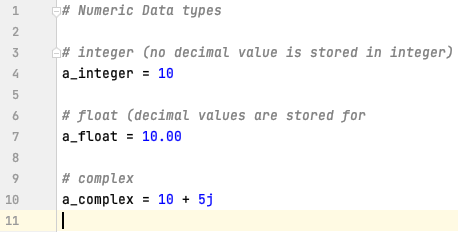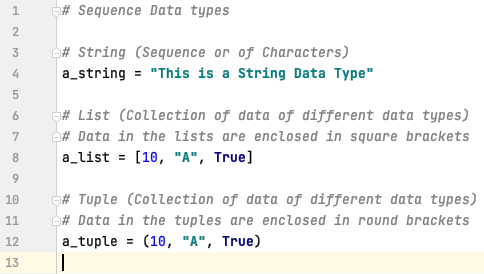Data Types
Data types are the key for any programming language. Various data types are present to do different operations and variables can store the corresponding data.
One of the greatest advantage for python is it is dynamically typed (i.e., data type is assigned during the run time based on the value assigned).
Unlike most of the programming languages, there is no need to define a variable with data type explicitly mentioned.
Below are different categories of data types in python.
- Numeric
- Sequence
- Boolean
- Dictionary
- Set
Let's have a look at the data types in each of these category.
Numeric:
- int - integer data type, to hold the whole numbers. No decimal values are stored in integer data type. This can hold both Positive and Negative values.
- float - float data type, to hold the numbers along with decimal values. This can hold both Positive and Negative values.
- complex - complex data type, complex numbers are a combination of real numbers and imaginary number (multiplied with 'j' (square root of -1)).
Sequence:
Data stored as a sequence in a variable (or collection of data of same data type or different data type).
- str - string data type, String is considered as collection (or array) of characters.
- list - List is a collection of data, This can hold data of different data types. Lists are specified in square brackets.
- tuple - Tuple is a collection of data, This can hold data of different data types. Tuples are specified in round brackets.
We can see that List and Tuple both look same except the way they are defined.
So, What's the difference between List & Tuple? Data in List can be updated, removed or new data can be added to the list. Where as Once defined, data in the tuple cannot be amended.
Tuple is the best choice when there is a set of values and they don't change through out the program (like constants) and Lists are flexible and can be used for any kind of transaction processing.
How can we access individual data elements? Individual element of a string, list or tuple can be accessed using index. Index starts from '0'.
Same way, data can be accessed in reverse as well, Last element would represent the index '-1'.
Boolean:
- bool - Boolean data type, to hold the boolean value i.e., True or False. This can only take 'True' or 'False' (case sensitive).
- dict - Dictionary data type, this hold a set of data with key and corresponding value separated by ':'. Data in dictionary can be accessed by using key and it has no corresponding index. Data in dictionary is enclosed in curly brackets.
- set - Set is a un ordered collection of data of different data types. Data cannot be accessed by using index. But, the elements of a set can be access through loop or by value. Data to a set can be assigned from List or tuple using 'set' function.
We have seen how to assign the data to a variable and how it determines the data type based on the data assigned in the code samples above. But, haven't really seen much about variables and I will share more details on variables in the next post.
If you have any Suggestions or Feedback, Please leave a comment below or use Contact Form.







Comments
Post a Comment